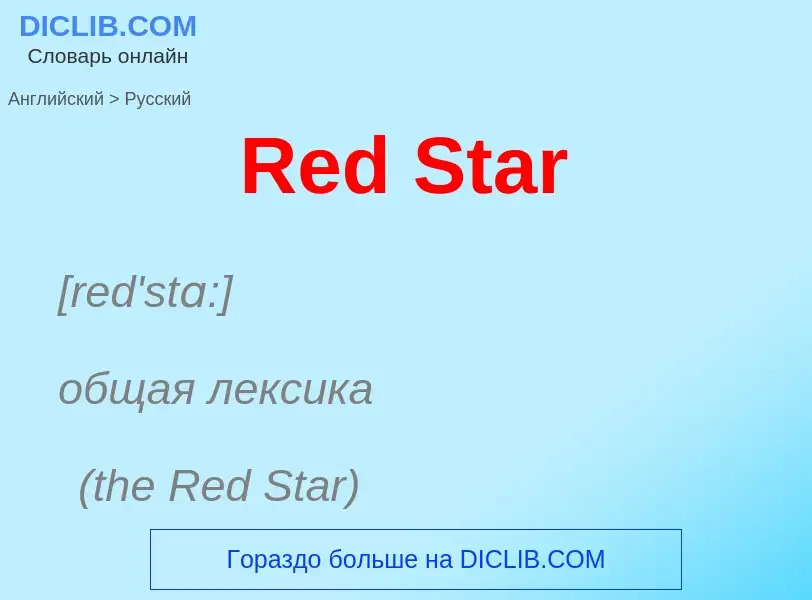Translation and analysis of words by ChatGPT artificial intelligence
On this page you can get a detailed analysis of a word or phrase, produced by the best artificial intelligence technology to date:
- how the word is used
- frequency of use
- it is used more often in oral or written speech
- word translation options
- usage examples (several phrases with translation)
- etymology
red Star - translation to English
[red'stɑ:]
общая лексика
(the Red Star)
красная звезда (эмблема)
[red'stɑ:]
астрономия
красная звезда
Definition
Wikipedia
A red star, five-pointed and filled, is a symbol that has often historically been associated with communist ideology, particularly in combination with the hammer and sickle, but is also used as a purely socialist symbol in the 21st century. It has been widely used in flags, state emblems, monuments, ornaments, and logos.
One interpretation sees the five points as representing the five fingers of the worker's hand, as well as the five populated continents (counting the Americas as one). A lesser-known suggestion is that in communist symbolism, the five points on the star were intended to represent the five social groups that would lead Russia to communism: the youth, the military, the industrial labourers, the agricultural workers or peasantry and the intelligentsia. In Soviet heraldry, the red star symbolized the Red Army and military service, as opposed to the hammer and sickle, which symbolized peaceful labour.
Different countries across Europe treat the symbol very differently. Some former Warsaw Pact nations have passed laws banning it, claiming that it represents "a totalitarian ideology", but other Eastern European countries hold a very positive view of it as a symbol of antifascism and resistance against Nazi occupation. Red Star has also been used in a non-communist context and before the emergence of this movement, in symbols of countries and states since the 19th Century. It appears for example on the flags of New Zealand and the U.S. state of California. Red star has also been used as logo by private agencies and corporations, such as the oil giant Texaco and beer multinational Heineken.


![A New Year tree with a red star in front of a church cupola in [[Volokolamsk]], Russia, 2010. A New Year tree with a red star in front of a church cupola in [[Volokolamsk]], Russia, 2010.](https://commons.wikimedia.org/wiki/Special:FilePath/Volokolamsk (Moscow Oblast) 12.jpg?width=200)


![Red Cavalry poster with the [[budenovka]], 1920 Red Cavalry poster with the [[budenovka]], 1920](https://commons.wikimedia.org/wiki/Special:FilePath/Вступайте в красную конницу, 1920.jpg?width=200)
![Kremlin Star]], [[Moscow]], (1937) Kremlin Star]], [[Moscow]], (1937)](https://commons.wikimedia.org/wiki/Special:FilePath/Kremlin Star.jpg?width=200)


![Flag of the [[Socialist Republic of Croatia]] Flag of the [[Socialist Republic of Croatia]]](https://commons.wikimedia.org/wiki/Special:FilePath/Flag of the Socialist Republic of Croatia.png ?width=200)
![NHS]] [[COVID-19]] [[lateral flow test]], manufactured in [[Xiamen]], [[Fujian Province]], [[China]]. NHS]] [[COVID-19]] [[lateral flow test]], manufactured in [[Xiamen]], [[Fujian Province]], [[China]].](https://commons.wikimedia.org/wiki/Special:FilePath/Scan of red star covid test.jpg?width=200)
![Komalah]] Komalah]]](https://commons.wikimedia.org/wiki/Special:FilePath/The_Official_Logo_Of_Komala.png?width=200)
![Popular Unity]] Popular Unity]]](https://commons.wikimedia.org/wiki/Special:FilePath/Uplogo2transparente-sinnombre.png?width=200)
![Symbol of the [[Party of Socialists of the Republic of Moldova]] Symbol of the [[Party of Socialists of the Republic of Moldova]]](https://commons.wikimedia.org/wiki/Special:FilePath/Party of Socialists of the Republic of Moldova logo.png?width=200)
![Symbol of the [[Abahlali baseMjondolo]] Symbol of the [[Abahlali baseMjondolo]]](https://commons.wikimedia.org/wiki/Special:FilePath/Abahlali_baseMjondolo_Logo.jpg?width=200)
![San Pellegrino]] bottle San Pellegrino]] bottle](https://commons.wikimedia.org/wiki/Special:FilePath/SanPellegrinoBottle A.jpg?width=200)
![Label of a [[Heineken]] bottle Label of a [[Heineken]] bottle](https://commons.wikimedia.org/wiki/Special:FilePath/Heineken Bottle.jpg?width=200)
![Logo of AKO, product of the [[Soviet Union]] Logo of AKO, product of the [[Soviet Union]]](https://commons.wikimedia.org/wiki/Special:FilePath/AKO Crabmeat 003.jpg?width=200)
![[[Texaco]] logo, circa 1913 [[Texaco]] logo, circa 1913](https://commons.wikimedia.org/wiki/Special:FilePath/Texaco Logo.jpg?width=200)
![[[Caltex]] logo, circa 1936 [[Caltex]] logo, circa 1936](https://commons.wikimedia.org/wiki/Special:FilePath/Caltex logo.png?width=200)
